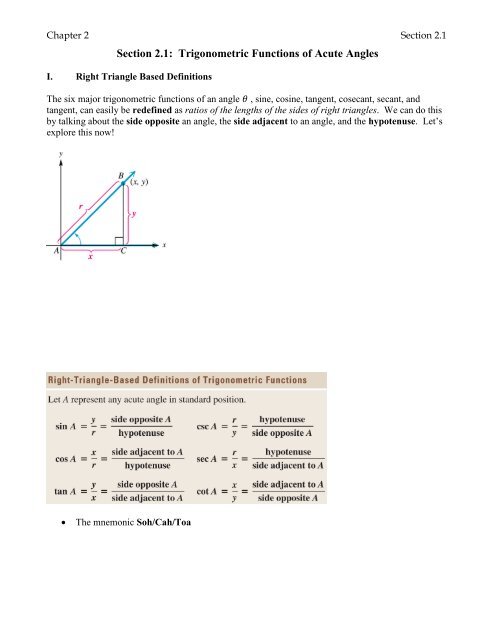Section 2.1: Trigonometric Functions of Acute Angles
Section 2.1: Trigonometric Functions of Acute Angles
Section 2.1: Trigonometric Functions of Acute Angles
You also want an ePaper? Increase the reach of your titles
YUMPU automatically turns print PDFs into web optimized ePapers that Google loves.
Chapter 2 <strong>Section</strong> <strong>2.1</strong><br />
<strong>Section</strong> <strong>2.1</strong>: <strong>Trigonometric</strong> <strong>Functions</strong> <strong>of</strong> <strong>Acute</strong> <strong>Angles</strong><br />
I. Right Triangle Based Definitions<br />
The six major trigonometric functions <strong>of</strong> an angle , sine, cosine, tangent, cosecant, secant, and<br />
tangent, can easily be redefined as ratios <strong>of</strong> the lengths <strong>of</strong> the sides <strong>of</strong> right triangles. We can do this<br />
by talking about the side opposite an angle, the side adjacent to an angle, and the hypotenuse. Let’s<br />
explore this now!<br />
The mnemonic Soh/Cah/Toa
Chapter 2 <strong>Section</strong> <strong>2.1</strong><br />
Example 1 (Finding Function Values): Find the sine, cosine, and tangent values for angles A and B<br />
in the figure.<br />
A<br />
II. C<strong>of</strong>unctions<br />
C<br />
B<br />
Notice in the previous example there was a connection between the sine <strong>of</strong> angle A and the cosine <strong>of</strong><br />
angle B, the cosine <strong>of</strong> angle A and the sine <strong>of</strong> angle B, etc….<br />
These connections are known as the c<strong>of</strong>unction identities. Let’s explore these in general.
Chapter 2 <strong>Section</strong> <strong>2.1</strong><br />
For any acute angle A, c<strong>of</strong>unction values <strong>of</strong> complementary angles are equal.<br />
.<br />
C<strong>of</strong>unction Identities<br />
sin A = cos(90 A) cos A = sin(90 A)<br />
tan A = cot(90 A) cot A = tan(90 A)<br />
sec A = csc(90 A) csc A = sec(90 A)<br />
Example 2 (Rewriting <strong>Functions</strong> in Terms <strong>of</strong> C<strong>of</strong>unctions): Write each function in terms <strong>of</strong> its<br />
c<strong>of</strong>unction.<br />
(a) sin 9°<br />
(b) cot 76°<br />
(c) csc 45°
Chapter 2 <strong>Section</strong> <strong>2.1</strong><br />
III. Increasing and Decreasing <strong>Functions</strong><br />
Note that as an angle A increases from 0° to 90°, y increases, x decreases, and r is always fixed.<br />
Example 3 (Comparing Function Values): Decide whether each statement is true or false.<br />
(a) sin 21° > sin 18°<br />
(b) tan 25° < tan 23°<br />
(c) csc 44° < csc 40°
Chapter 2 <strong>Section</strong> <strong>2.1</strong><br />
IV. Special <strong>Angles</strong><br />
The 30°-60°-90° triangles. To start, let’s bisect one angle <strong>of</strong> an equilateral triangle.<br />
Example 4 (Finding values for 30°): Find the six trigonometric function values for a 30° angle.
Chapter 2 <strong>Section</strong> <strong>2.1</strong><br />
45°- 45°-90° Right Triangles.<br />
Example 5 (Practice): Now you find the six values for 45° angle.<br />
Function Values <strong>of</strong> Special <strong>Angles</strong><br />
<br />
30°<br />
60°<br />
45°<br />
sin<br />
cos<br />
tan

















